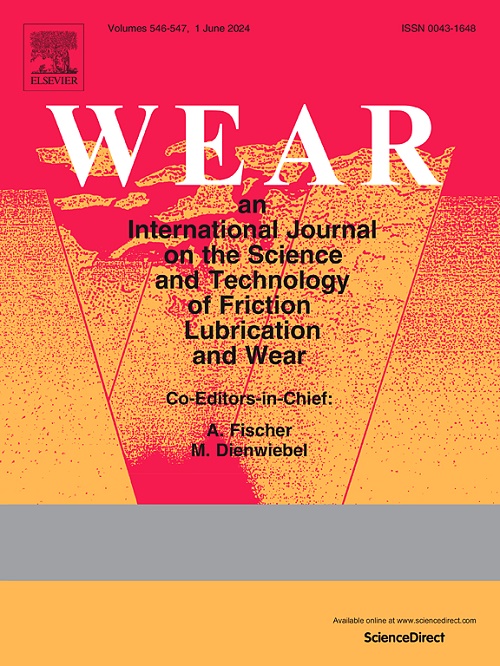一种改善低成本钛合金摩擦学性能的表面工程新技术
IF 5.3
1区 工程技术
Q1 ENGINEERING, MECHANICAL
引用次数: 0
摘要
为了提高低成本β (LCB)钛合金(Ti-6.8Mo-4.5Fe-1.5Al)的摩擦学性能,开发了一种新的表面工程技术,将本体固溶处理与催化陶瓷转化处理(C3T)相结合。这种新的集成技术可以有效地解决以往固溶处理与传统陶瓷转化处理(C2T)相结合形成的氧化层-基体界面结合强度低的技术局限性。在干燥条件下对WC球进行了往复销盘滑动磨损试验。通过对电子结构变化的计算分析和对表面结构的后处理,探讨了金的催化机理。采用基于轮廓学的压痕塑性测量法(PIP)来评估表面处理对大块材料性能的影响。实验结果表明,新型C3T可使LCB钛合金的耐磨性提高约200倍;氧化层厚度是c2t处理样品的20倍;摩擦系数从未处理样品的0.4 ~ 0.8下降到C3T处理样品的0.1 ~ 0.2。C3T处理的LCB钛合金在空气中与WC球摩擦时,由典型的重度黏着磨损机制转变为轻度磨粒磨损机制;消除了常规c2t处理表面因界面结合弱而产生的脱层磨损。有趣的是,预先添加金膜降低了表面硬度,同时提高了耐磨性,并在摩擦学过程中起到润滑剂的作用,特别是在低负荷下,由于金的柔软和化学稳定性。本文章由计算机程序翻译,如有差异,请以英文原文为准。
A novel surface engineering technique for improving tribological performance of low-cost beta titanium alloy
A novel surface engineering technique has been developed to integrate bulk solution treatment with Catalytic Ceramic Conversion Treatment (C3T) to enhance the tribological performance of low-cost beta (LCB) titanium alloy (Ti-6.8Mo-4.5Fe-1.5Al). This new integrated technique can effectively address the technical limitation of low bonding strength at the oxide layer-matrix interface formed by the previous combination of solution treatment with conventional Ceramic Conversion Treatment (C2T). Reciprocating pin-on-disc sliding wear tests were performed against WC balls under dry conditions. Computational analyses of electronic structure changes and post-examination of the surface structure were conducted to investigate the catalytic mechanism of gold. Profilometry-based Indentation Plastometry (PIP) was carried out to assess the impact of surface treatment on the bulk material properties.
Experimental results demonstrate that the wear resistance of the LCB titanium alloy can be improved by approximately 200 times by the new C3T; the oxide layer is 20 times thicker than that of the C2T-treated samples; the coefficient of friction decreased from 0.4 to 0.8 for untreated samples to 0.1–0.2 for the C3T treated samples. The typical wear mechanism of titanium, characterised by severe adhesive wear, is replaced by mild abrasive wear for C3T treated LCB titanium alloy when sliding against WC balls in air; and delamination wear caused by weak interface bonding in conventional C2T-treated surface is eliminated. Interestingly, the pre-addition of a gold film decreased the surface hardness while improving the wear resistance, and acting as a lubricant in the tribological process, particularly under low loads due to the soft and chemically stable nature of gold.
求助全文
通过发布文献求助,成功后即可免费获取论文全文。
去求助
来源期刊

Wear
工程技术-材料科学:综合
CiteScore
8.80
自引率
8.00%
发文量
280
审稿时长
47 days
期刊介绍:
Wear journal is dedicated to the advancement of basic and applied knowledge concerning the nature of wear of materials. Broadly, topics of interest range from development of fundamental understanding of the mechanisms of wear to innovative solutions to practical engineering problems. Authors of experimental studies are expected to comment on the repeatability of the data, and whenever possible, conduct multiple measurements under similar testing conditions. Further, Wear embraces the highest standards of professional ethics, and the detection of matching content, either in written or graphical form, from other publications by the current authors or by others, may result in rejection.
 求助内容:
求助内容: 应助结果提醒方式:
应助结果提醒方式:


